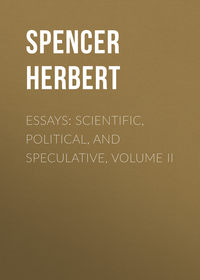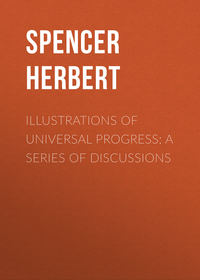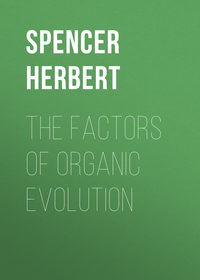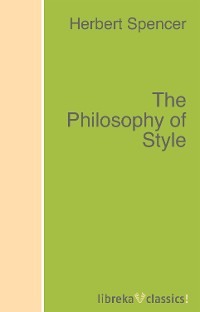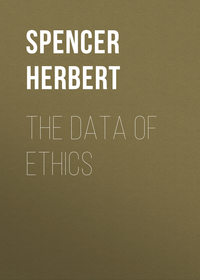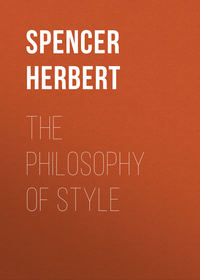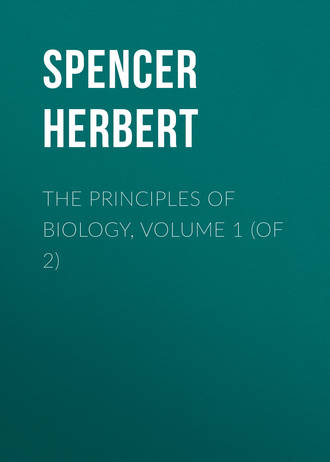 полная версия
полная версияThe Principles of Biology, Volume 1 (of 2)
43
For explanations, see "Illogical Geology," Essays, Vol. I. How much we may be misled by assuming that because the remains of creatures of high types have not been found in early strata, such creatures did not exist when those strata were formed, has recently (1897) been shown by the discovery of a fossil Sea-cow in the lower Miocene of Hesse-Darmstadt. The skeleton of this creature proves that it differed from such Sirenian mammals as the existing Manatee only in very small particulars: further dwindling of disused parts being an evident cause. The same is true as regards, now, we consider that since the beginning of Miocene days this aberrant type of mammal has not much increased its divergence from the ordinary mammalian type; if we then consider how long it must have taken for this large aquatic mammal (some eight or ten feet long) to be derived by modification from a land-mammal; and if then we contemplate the probable length of the period required for the evolution of that land-mammal out of a pre-mammalian type; we seem carried back in thought to a time preceding any of our geologic records. We are shown that the process of organic evolution has most likely been far slower than is commonly supposed.
44
Since this passage was written, in 1863, there has come to light much more striking evidence of change from a more generalized to a less generalized type during geologic time. In a lecture delivered by him in 1876, Prof. Huxley gave an account of the successive modifications of skeletal structure in animals allied to the horse. Beginning with the Orohippus of the Eocene formation, which had four complete toes on the front limb and three toes on the hind limb, he pointed out the successive steps by which in the Mesohippus, Miohippus, Protohippus, and Pliohippus, there was a gradual approach to the existing horse.
45
Several of the arguments used in this chapter and in that which follows it, formed parts of an essay on "The Development Hypothesis," originally published in 1852.
46
Studies from the Morphological Laboratory in the University of Cambridge, vol. vi, p. 84.
47
Ibid., p. 81.
48
Studies from the Morphological Laboratory in the University of Cambridge, vol. vi, p. 89.
49
Early in our friendship (about 1855) Prof. Huxley expressed to me his conviction that all the higher articulate animals have twenty segments or somites. That he adhered to this view in 1880, when his work on The Crayfish was published, is shown by his analysis there given of the twenty segments existing in this fluviatile crustacean; and adhesion to it had been previously shown in 1877, when his work on The Anatomy of Invertebrated Animals was published. On p. 398 of that work he writes: – "In the abdomen there are, at most, eleven somites, none of which, in the adult, bear ambulatory limbs. Thus, assuming the existence of six somites in the head, the normal number of somites in the body of insects will be twenty, as in the higher Crustacea and Arachnida." To this passage, however, he puts the note: – "It is open to question whether the podical plates represent a somite; and therefore it must be recollected that the total number of somites, the existence of which can be actually demonstrated in insects, is only seventeen, viz., four for the head, three for the thorax, and ten for the abdomen." I have changed the number twenty, which in the original edition occurred in the text, to the number seventeen in deference to suggestions made to me; though I find in Dr. Sharp's careful and elaborate work on the Insecta, that Viallanes and Cholodkovsky agree with Huxley in believing that there are six somites in the insect-head. The existence of a doubt on this point, however, does not essentially affect the argument, since there is agreement among morphologists respecting the constancy of the total number of somites in insects.
50
To avoid circumlocution I let these words stand, though they are not truly descriptive; for the prosperity of imported species is largely, if not mainly, caused by the absence of those natural enemies which kept them down at home.
51
While these pages are passing through the press (in 1864), Dr. Hooker has obliged me by pointing out that "plants afford many excellent examples" of analogous transitions. He says that among true "water plants," there are found, in the same species, varieties which have some leaves submerged and some floating; other varieties in which they are all floating; and other varieties in which they are all submerged. Further, that many plants characterized by floating leaves, and which have all their leaves floating when they grow in deeper water, are found with partly aerial leaves when they grow in shallower water; and that elsewhere they occur in almost dry soil with all their leaves aerial.
52
It will be seen that the argument naturally leads up to this expression – Survival of the Fittest – which was here used for the first time. Two years later (July, 1866) Mr. A. R. Wallace wrote to Mr. Darwin contending that it should be substituted for the expression "Natural Selection." Mr. Darwin demurred to this proposal. Among reasons for retaining his own expression he said that I had myself, in many cases, preferred it – "continually using the words Natural Selection." (Life and Letters, &c., vol. III, pp. 45-6.) Mr. Darwin was quite right in his statement, but not right in the motive he ascribed to me. My reason for frequently using the phrase "Natural Selection," after the date at which the phrase "Survival of the Fittest" was first used above, was that disuse of Mr. Darwin's phrase would have seemed like an endeavour to keep out of sight my own indebtedness to him, and the indebtedness of the world at large. The implied feeling has led me ever since to use the expressions Natural Selection and Survival of the Fittest with something like equal frequency.
53
I am indebted to Mr. [now Sir W.] Flower for the opportunity of examining the many skulls in the Museum of the College of Surgeons for verification of this. Unfortunately the absence, in most cases, of some or many teeth, prevented me from arriving at that specific result which would have been given by weighing a number of the under jaws in each race. Simple inspection, however, disclosed a sufficiently-conspicuous difference. The under jaws of Australians and Negroes, when collated with those of Englishmen, were visibly larger, not only relatively but absolutely. One Australian jaw only seemed about of the same size as an average English jaw; and this (probably the jaw of a woman), belonging as it did to a smaller skull, bore a greater ratio to the whole body of which it formed part, than did an English jaw of the same actual size. In all the other cases, the under jaws of these inferior races (containing larger teeth than our own) were absolutely more massive than our own – often exceeding them in all dimensions; and relatively to their smaller skeletons were much more massive. Let me add that the Australian and Negro jaws are thus strongly contrasted, not with all British jaws, but only with the jaws of the civilized British. An ancient British skull in the collection possesses a jaw almost or quite as massive as those of the Australian skulls. All this is in harmony with the alleged relation between greater size of jaws and greater action of jaws, involved by the habits of savages.
[In 1891 Mr. F. Howard Collins carefully investigated this matter: measuring ten Australian, ten Ancient British, and ten recent English skulls in the College of Surgeons Museum. The result proved an absolute difference of the kind above indicated, and a far greater relative difference. To ascertain this last a common standard of comparison was established – an equal size of skull in all the cases; and then when the relative masses or cubic sizes of the jaws were calculated, the result which came out was this: – Australian jaw, 1948; Ancient British jaw, 1135; Recent English jaw, 1030. "Hence," in the words of Mr. Collins, "the mass of the Recent English jaw is, roughly speaking, half that of the Australian relatively to that of the skull, and a ninth less than that of the Ancient British." He adds verifying evidence from witnesses who have no hypothesis to support – members of the Odontological Society. The Vice-President, Mr. Mummery, remarks of the Australians that "the jaw-bones are powerfully developed, and large in proportion to the cranium."]
54
As bearing on the question of the varieties of Man, let me here refer to a paper on "The Origin of the Human Races" read before the Anthropological Society, March 1st, 1864, by Mr. Alfred Wallace. In this paper, Mr. Wallace shows that along with the attainment of that intelligence implied by the use of implements, clothing, &c., there arises a tendency for modifications of brain to take the place of modifications of body: still, however, regarding the natural selection of spontaneous variations as the cause of the modifications. But if the foregoing arguments be valid, natural selection here plays but the secondary part of furthering the adaptations otherwise caused. It is true that, as Mr. Wallace argues, and as I have myself briefly indicated (see Westminster Review, for April, 1852, pp. 496-501), the natural selection of races leads to the survival of the more cerebrally-developed, while the less cerebrally-developed disappear. But though natural selection acts freely in the struggle of one society with another; yet, among the units of each society, its action is so interfered with that there remains no adequate cause for the acquirement of mental superiority by one race over another, except the inheritance of functionally-produced modifications.
55
Darwin and after Darwin, Part II, p. 99.
56
Essays upon Heredity, vol. i, p. 90.
57
In a letter published by Dr. Romanes in Nature, for April 26, 1894, he alleges three reasons why "as soon as selection is withdrawn from an organ the minus variations of that organ outnumber the plus variations." The first is that "the survival-mean must descend to the birth-mean." The interpretation of this is that if the members of a species are on the average born with an organ of the required size, and if they are exposed to natural selection, then those in which the organ is relatively small will some of them die, and consequently the mean size of the organ at adult age will be greater than at birth. Contrariwise, if the organ becomes useless and natural selection does not operate on it, this difference between the birth-mean and the survival-mean disappears. Now here, again, the plus variations and their effects are ignored. Supposing the organ to be useful, it is tacitly assumed that while minus variations are injurious, plus variations are not injurious. This is untrue. Superfluous size of an organ implies several evils: – Its original cost is greater than requisite, and other organs suffer; the continuous cost of its nutrition is unduly great, involving further injury; it adds needlessly to the weight carried and so again is detrimental; and there is in some cases yet a further mischief – it is in the way. Clearly, then, those in which plus variations of the organ have occurred are likely to be killed off as well as those in which minus variations have occurred; and hence there is no proof that the survival-mean will exceed the birth-mean. Moreover the assumption has a fatal implication. To say that the survival-mean of an organ is greater than the birth-mean is to say that the organ is greater in proportion to other organs than it was at birth. What happens if instead of one organ we consider all the organs? If the survival-mean of a particular organ is greater than its birth-mean, the survival mean of each other organ must also be greater. Thus the proposition is that every organ has become larger in relation to every other organ! – a marvellous proposition. I need only add that Dr. Romanes' inferences with respect to the two other causes – atavism and failing heredity – are similarly vitiated by ignoring the plus variations and their effects.
58
Westminster Review, January, 1860. See also Essays, &c., vol. i, p. 290.
59
"On Orthogenesis and the Impotence of Natural Selection in Species-Formation," pp. 2, 19, 22, 24.
60
Address to Plymouth Institution, at opening of Session 1895-6.
61
Westminster Review, April, 1857. "Progress: its Law and Cause." See also Essays, vol. i.
62
It may be needful to remark, that by the proposed expression it is intended to define – not Life in its essence; but, Life as manifested to us – not Life as a noumenon: but, Life as a phenomenon. The ultimate mystery is as great as ever: seeing that there remains unsolved the question – What determines the co-ordination of actions?
63
Prin. of Phys., 2nd edit., p. 77.
64
Ibid., 3rd edit., p 249.
65
Ibid., p. 124.
66
Agassiz and Gould, p. 274.
67
Prin. of Phys., 3rd edit., p. 964.
68
"Parthenogenesis," p. 8.
69
Prin. of Phys., p. 92.
70
Ibid., p. 93.
71
Ibid., p. 917.
72
"A General Outline of the Animal Kingdom." By Prof. T. R. Jones, F. G. S., p. 61.
73
Carpenter.
74
Prin. of Phys., p. 873.
75
Ibid., p. 203.
76
Ibid., p. 209.
77
Ibid., p. 249.
78
Ibid., p. 249.
79
Ibid., p. 250.
80
Prin. of Phys., p. 256.
81
Ibid., p. 212.
82
Ibid., p. 266.
83
Prin. of. Phys., p. 267.
84
Ibid., p. 276.
85
Ibid., 2nd edit., p. 115.
86
Prin. of Phys., p. 954.
87
Ibid., p. 958.
88
Ibid., p. 688.
89
Ibid., p. 958.
90
"A General Outline of the Animal Kingdom." By Professor T. R. Jones, p. 61.
91
Prin. of Phys., p. 907.
92
Should it be objected that in the higher plants the sperm-cell and germ-cell differ, though no distinct co-ordinating system exists, it is replied that there is co-ordination of actions, though of a feeble kind, and that there must be some agency by which this is carried on.
93
It is a significant fact that amongst the diœcious invertebrata, where the nutritive system greatly exceeds the other systems in development, the female is commonly the largest, and often greatly so. In some of the Rotifera the male has no nutritive system at all. See Prin. of Phys., p. 954.
94
Prin. of Phys., p. 908.
95
"Parthenogenesis," pp. 66, 67.
96
"Lectures on Animal Chemistry." By Dr. Bence Jones. Medical Times, Sept. 13th, 1851. See also Prin. of Phys., p. 171.
97
Cyclopædia of Anatomy and Physiology, Vol. IV, p. 506.
98
From a remark of Drs. Wagner and Leuckart this chemical evidence seems to have already suggested the idea that the sperm-cell becomes "metamorphosed into the central parts of the nervous system." But though they reject this assumption, and though the experiments of Mr. Newport clearly render it untenable, yet none of the facts latterly brought to light conflict with the hypothesis that the sperm-cell contains unorganized co-ordinating matter.
99
Quain's Elements of Anatomy, p. 672.
100
The maximum weight of the horse's brain is 1 lb. 7 ozs.; the human brain weighs 3 lbs., and occasionally as much as 4 lbs.; the brain of a whale, 75 feet long, weighed 5 lbs. 5 ozs.; and the elephant's brain reaches from 8 lbs. to 10 lbs. Of the whale's fertility we know nothing; but the elephant's quite agrees with the hypothesis. The elephant does not attain its full size until it is thirty years old, from which we may infer that it arrives at a reproductive age later than man does; its period of gestation is two years, and it produces one at a birth. Evidently, therefore, it is much less prolific than man. See Müller's Physiology (Baly's translation), p. 815, and Quain's Elements of Anatomy, p. 671.
101
That the size of the nervous system is the measure of the ability to maintain life, is a proposition that must, however, be taken with some qualifications. The ratio between the amounts of gray and white matter present in each case is probably a circumstance of moment. Moreover, the temperature of the blood may have a modifying influence; seeing that small nervous centres exposed to rapid oxidation will be equivalent to larger ones more slowly oxidized. Indeed, we see amongst mankind, that though, in the main, size of brain determines mental power, yet temperament exercises some control. There is reason to think, too, that certain kinds of nervous action involve greater consumption of nervous tissue than others; and this will somewhat complicate the comparisons. Nevertheless, these admissions do not affect the generalization as a whole, but merely prepare us to meet with minor irregularities.
102
Let me here note in passing a highly significant implication. The development of nervous structures which in such cases take place, cannot be limited to the finger-ends. If we figure to ourselves the separate sensitive areas which severally yield independent feelings, as constituting a network (not, indeed, a network sharply marked out, but probably one such that the ultimate fibrils in each area intrude more or less into adjacent areas, so that the separations are indefinite), it is manifest that when, with exercise, the structure has become further elaborated, and the meshes of the network smaller, there must be a multiplication of fibres communicating with the central nervous system. If two adjacent areas were supplied by branches of one fibre, the touching of either would yield to consciousness the same sensation: there could be no discrimination between points touching the two. That there may be discrimination, there must be a distinct connection between each area and the tract of grey matter which receives the impressions. Nay more, there must be, in this central recipient-tract, an added number of the separate elements which, by their excitements, yield separate feelings. So that this increased power of tactual discrimination implies a peripheral development, a multiplication of fibres in the trunk-nerve, and a complication of the nerve-centre. It can scarcely be doubted that analogous changes occur under analogous conditions throughout all parts of the nervous system – not in its sensory appliances only, but in all its higher co-ordinating appliances, up to the highest.
103
Essays upon Heredity, p. 87.
104
Les Maladies des Vers à soie, par L. Pasteur, Vol. I, p. 39.
105
Curiously enough, Weismann refers to, and recognizes, syphilitic infection of the reproductive cells. Dealing with Brown-Séquard's cases of inherited epilepsy (concerning which, let me say, that I do not commit myself to any derived conclusions), he says: – "In the case of epilepsy, at any rate, it is easy to imagine [many of Weismann's arguments are based on things 'it is easy to imagine'] that the passage of some specific organism through the reproductive cells may take place, as in the case of syphilis" (p. 82). Here is a sample of his reasoning. It is well known that epilepsy is frequently caused by some peripheral irritation (even by the lodging of a small foreign body under the skin), and that, among peripheral irritations causing it, imperfect healing is one. Yet though, in Brown-Séquard's cases, a peripheral irritation caused in the parent by local injury was the apparent origin, Weismann chooses gratuitously to assume that the progeny were infected by "some specific organism," which produced the epilepsy! And then though the epileptic virus, like the syphilitic virus, makes itself at home in the egg, the parental protoplasm is not admitted!
106
Philosophical Transactions of the Royal Society for the Year 1821, Part I, pp. 20-24.
107
It will, I suppose, be said that the non-inheritance of mutilations constitutes evidence of the kind here asked for. The first reply is that the evidence is conflicting, as it may well be. It is forgotten that to have valid evidence of non-inheritance of mutilations, it is requisite that both parents shall have undergone mutilation, and that this does not often happen. If they have not, then, assuming the inheritableness of mutilations, there would, leaving out other causes, be an equal tendency to appearance and non-appearance of the mutilation in offspring. But there is another cause – the tendency to reversion, which ever works in the direction of cancelling individual characters by the return to ancestral characters. So that even were the inheritance of mutilations to be expected (and for myself I may say that its occurrence surprises me), it could not be reasonably looked for as more than exceptional: there are two strong countervailing tendencies. But now, in the second place, let it be remarked that the inheritance or non-inheritance of mutilations is beside the question. The question is whether modifications of parts produced by modifications of functions are inheritable or not. And then, by way of disproof of their inheritableness, we are referred to cases in which the modifications of parts are not produced by modifications of functions, but are otherwise produced!
108
See First Principles, Part II, Chap. XXII, "Equilibration."
109
Principles of Biology, § 46, (No. 8. April, 1863).
110
Ibid. This must not be understood as implying that while the mass increases as the cubes, the quantity of motion which can be generated increases only as the squares; for this would not be true. The quantity of motion is obviously measured, not by the sectional areas of the muscles alone, but by these multiplied into their lengths, and therefore increases as the cubes. But this admission leaves untouched the conclusion that the ability to bear stress increases only as the squares; and thus limits the ability to generate motion, by relative incoherence of materials.


